Breeds and Breeding
The choice of breed or strain of cattle on a farm should account for the capacity of animals to adapt and thrive under local conditions as well as their potential to resist disease. It is often the case that indigenous breeds and strains are best suited to the prevailing environment, although there will also be economic considerations concerning efficiency and value of the end product.
While most beef and dairy breeds are well suited to outdoor systems, in beef production the use of traditional, early maturing breeds will probably better suit a forage-based system. It may also be the case that high-yielding, high genetic merit dairy cows would be unsuited for largely forage-based feeding systems.
Our sustainable livestock practices include, as far as is practical, a closed herd policy, which in turn encourages selection on the basis of individual farm needs, as well as the development of greater resistance to the spectrum of disease present on a specific farm. Having a closed herd policy also ensures greater biosecurity.
Is there a need for a sustainable farming approach to breeding?
There are two basic reasons why different strains or breeds may be needed for extensive livestock production, and in particular those that adhere to organic farming principles:
- There may be a difference in the emphasis and range of traits required i.e. as well as production, other more functional traits may also be desirable;
- The ‘genotype by environment interaction’ (or ‘G x E’) is a phenomena whereby animals being selected for production traits in one environment may perform very differently in another environment (Pryce et al., 2004).
There may be significant management and other conditions on extensive and low input farms that require different type of animal compared with more intensive systems, including:
- The need for a largely forage based feeding system (whereas breeds used in intensive systems have tended to be those selected for high concentrate diets)
- The emphasis on reduced veterinary inputs and disease tolerance and resistance (in intensive systems health has not been a selection parameter and some positive health traits may have been lost as a consequence of selecting animals mainly for production)
- The requirement for outdoor exercise may require a more hardy animal, although this will depend on the extent of exposure to climatic extremes
- High animal welfare aspirations require emphasis on key parameters such as longevity (over recent years, the longevity of intensive dairy herds is low as a consequence of the high production stress on animals)
- Some low input and mixed farming systems may be more multi-functional than single enterprise systems and in such situations, dual purpose breeds may be the best option. In addition to this, a poor market for ‘dairy’ calves may result in very high slaughter rates of young offspring that are not well suited to beef production
The Suitability of High Genetic Merit Dairy Breeds
Our sustainable livestock principles support predominantly forage-based system that have an emphasis on maintaining animal health through improved welfare and a reduction in the use of routine, conventional veterinary treatments. However, many of the breeds used in intensive farming could be considered as ‘high maintenance’ animals, requiring regular prophylactic veterinary treatments and high energy concentrated feeds to meet their potential. Such breeds may be unable to fulfil their potential performance under low input and organic system (van Diepen et al., 2007).
Genetic selection has increased production levels of livestock species considerably. However, apart from a favorable increase in production, animals that have been selected for high production efficiency seem to be more at risk of behavioral, physiological and immunological problems (Rauw et al., 1998). The main breeding goal of the dominant dairy breed in many countries, the Holstein-Friesian, has been for increased milk yields. This has meant that other genetic traits such as longevity, fertility and animal health have been compromised (Pryce et al., 1999). This has relevance for low input, forage based systems in that the responses to selection on a low input feed system tend to be lower than those in a high input system (Weller et al, 2002) and there is a requirement for robustness and disease resistance.
There may also be market opportunities associated with the end product that dictate the breed type required, particularly for those involved in processing of milk products.
Breeding for Disease Resistance
Selection for milk production traits may have led to an increase in the incidence of some health disorders, such as mastitis and lameness (e.g. Emanuelson, 1988; Lyons et al., 1991; Uribe et al., 1995; Pryce et al., 1997 and Pryce et al., 1998). It may be the case that future breeding programs for dairy cattle will increasingly include selection for resistance (Fitzpatrick et al., 1999), although there are risks that improvements in one trait achieved by selective breeding are often associated with losses in other traits.
Pryce et al (2004) identified the following main limitations to genetic progress in disease traits:
- The low heritability estimates of such traits;
- The lack of reliable phenotypic records;
- The unfavorable genetic relationship between production and fitness traits i.e those associated with survival and reproductive rate (Goddard, 2009); and
- The number of offspring required to get an accurate breeding value (about 4 to 10 times as many as for production traits).
As well as the feasibility of selection for traits where little genetic variation may exist, there have also been concerns expressed regarding the sustainability of breeding for resistance in the face of continuous evolution of pathogens, the risk of selection for resistance to a given disease on the genetic resistance to other diseases as well as the very high costs associated with developing breeding programs that only result in slow progression (Berry et al., 2011).
Although the heritabilities of health and fertility traits are low, the genetic variability has been shown to be reasonably high, suggesting that a significant genetic improvement in disease resistance is achievable if proper procedures are applied (Pryce et al., 2004 in Vaarst et al., 2004, Jansen, 1985 and Emanuelson, 1988) and there is access to large databases of phenotypes on health and disease. The use of techniques such as genomic selection will prove beneficial when breeding for disease traits of low heritability, and especially those that are only apparent when adult animals are exposed to the necessary disease risks (Berry et al., 2001). Well integrated recording schemes in the Scandinavian countries have enabled the adoption of total merit indexes (TMI), including reproduction and health traits, into selection schemes (Philipsson and Lindhé, 2003). In spite of low heritabilities for disease traits, genetic variation for disease incidence is economically important and justifies including disease in breeding programs (Shook, 1989) and genetic selection against common health disorders using data from on-farm recording systems is possible (Zwald et al., 2004). The inclusion of genomic data substantially improves the reliability of genetic selection for health traits (Parker Gaddis et al., 2014).
Selecting for Mastitis Resistance
It is possible to select for increased resistance to mastitis in dairy cattle and selection for increased milk production will result 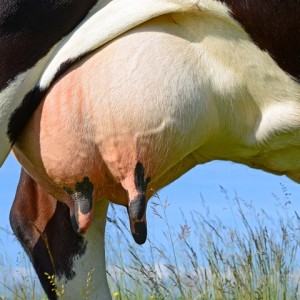 in an unfavorable correlated increase in mastitis incidence if mastitis is ignored in the breeding program (Heringstad et al., 2003). In most countries selection for somatic cell count (SCC) is used as an indirect approach to selection for mastitis resistance (Rupp and Boichard, 2003) as it is strongly correlated with mastitis and has a higher heritability than mastitis resistance (Thompson-Crispi et al., 2014).
in an unfavorable correlated increase in mastitis incidence if mastitis is ignored in the breeding program (Heringstad et al., 2003). In most countries selection for somatic cell count (SCC) is used as an indirect approach to selection for mastitis resistance (Rupp and Boichard, 2003) as it is strongly correlated with mastitis and has a higher heritability than mastitis resistance (Thompson-Crispi et al., 2014).
In some Scandinavian countries, there has been a long history of selecting directly for mastitis resistance which has in part been made possible as a result of a comprehensive national recording program (Østerås et al., 2007). Positive selection responses for disease resistance (mastitis, ketosis and retained placenta) in the Norwegian Red breed over five generations are reported by Heringstad et al., (2007).
More countries now have routine national genetic and genomic evaluations for clinical mastitis, including a French Total Merit Index (ISU) for the three most common dairy breeds in France, the Holstein, Montbéliarde and Normande (Govignon-Gion et al., 2012) and in Canada there is a routine genetic evaluation system for mastitis resistance for Holstein, Ayrshire and Jersey breeds (Jamrozik et al., 2013).
There are potential problems associated with breeding directly for mastitis resistance in that this may result in increased susceptibility to other harmful pathogens (Thompson-Crispi et al., 2014). There is also a risk that too low a SCC may be associated with increased risk of clinical mastitis (Suriyasathaporn et al., 2000).
For more on Mastitis
Selecting for Improved Lameness
Genetic, as well as environmental, and infectious factors, are associated with lameness in dairy cows (Baird et al., 2009). Despite the relatively low heritability of recorded clinical lameness (Boettcher et al., 1998), selection of specific sires across and 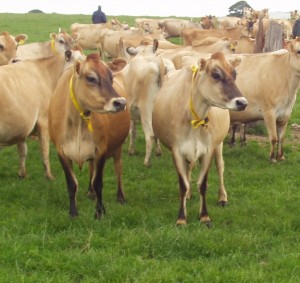 within breeds could be an option for increasing genetic resistance to lameness in dairy cattle (Chawala et al., 2013). Selection for resistance to lameness will result in a low rate of genetic gain but, for example, crossbreeding with Jersey sires can be an alternative to increase genetic resistance to lameness in Holstein cattle (Chawala et al., 2011). The heritability estimates for different claw disorders can vary considerably. Conditions such as digital dermatitis and interdigital hyperplasia tend to have higher estimates and therefore there are likely to be good responses to selection for resistance (van der Waaij et al., 2005).
within breeds could be an option for increasing genetic resistance to lameness in dairy cattle (Chawala et al., 2013). Selection for resistance to lameness will result in a low rate of genetic gain but, for example, crossbreeding with Jersey sires can be an alternative to increase genetic resistance to lameness in Holstein cattle (Chawala et al., 2011). The heritability estimates for different claw disorders can vary considerably. Conditions such as digital dermatitis and interdigital hyperplasia tend to have higher estimates and therefore there are likely to be good responses to selection for resistance (van der Waaij et al., 2005).
Differences have been found between breeds in claw score traits for certain foot conditions (Huang et al., 1995). Ayrshires and Jerseys had better scores than other breeds. The Brown Swiss had the worst scores for corkscrew claws, laminitis and sole ulcers. White line score was worst in Guernseys and heel erosion and digital dermatitis were worst in Friesians.
There is evidence that Jerseys tend to have harder feet and less lameness (Chesterton et al., 1989). It has also been suggested that heavier cows are more prone to clinical lameness (Boettcher et al., 1998), although cows genetically pre-disposed for high body condition score may have fewer locomotion and lameness issues (Kougioumtzis et al., 2014). Claw color has also been implicated in lameness, with cattle with less pigmented feet being more prone to lameness (Chesterton et al., 1989). Holstein and British Friesian cattle with white feet tend to have softer claws and are more prone to lameness problems than other breeds such as the Jersey and Brown Swiss with harder black hooves (Webster, 1993).
More on Lameness
Good Practice for Dairy Farmers
- Where relevant information is available, resistance to disease should be taken into consideration over productivity when breeding decisions are made.
- Mismatching of bull and dam, resulting in calving difficulties, should be avoided.
- While animals suffering from disease or injury should be culled in good time, longevity should be encouraged in dairy and suckler cows.
- For dairy producers, the opportunity to select bulls with low Somatic Cell Counts (SCC) levels in daughters should be utilised.
- Overall lifetime productivity should be considered above high productivity alone in dairy bull selection.


 British English
British English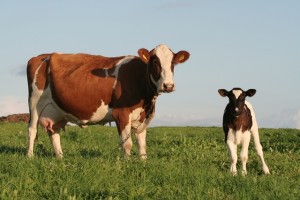
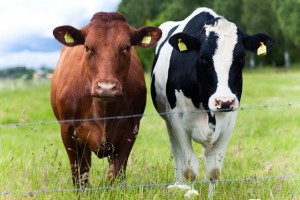
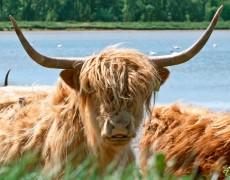
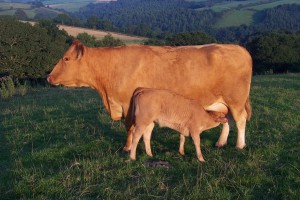


Comments are closed.